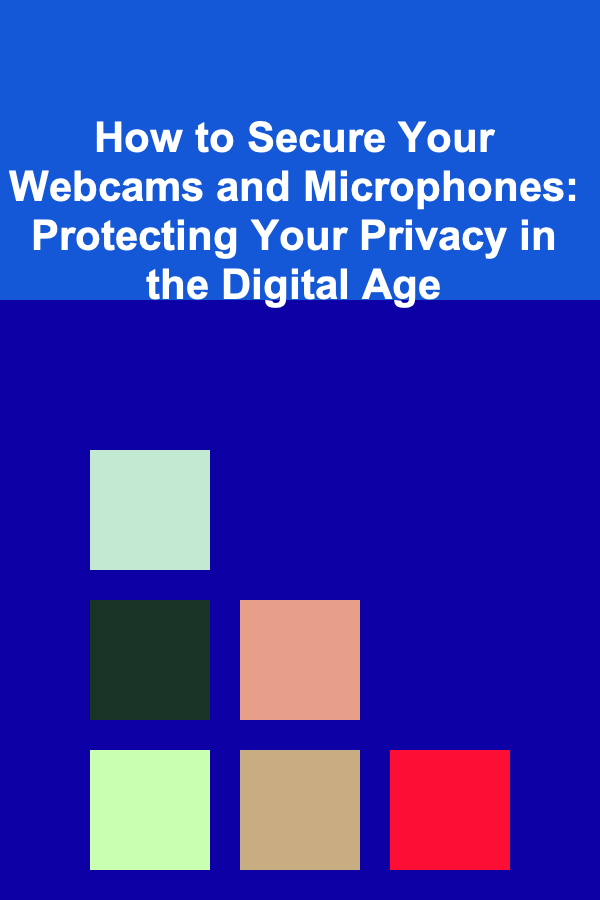
How to Secure Your Webcams and Microphones: Protecting Your Privacy in the Digital Age
ebook include PDF & Audio bundle (Micro Guide)
$12.99$7.99
Limited Time Offer! Order within the next:

In our increasingly connected world, webcams and microphones are vital tools for communication, work, and entertainment. From video calls and virtual meetings to podcasts and streaming, these devices have become commonplace in our daily lives. However, as convenient as they are, they also represent significant security and privacy risks. Cybercriminals can exploit vulnerabilities in these devices to spy on individuals, steal sensitive information, or carry out malicious activities.
Securing your webcams and microphones is not just a technical concern but also a matter of personal privacy. In this article, we will delve into why it's essential to secure your webcams and microphones, common threats you face, and practical steps you can take to ensure your privacy and safety.
Understanding the Risks: Why Webcam and Microphone Security Matter
Before diving into specific security measures, it's crucial to understand the risks associated with unsecured webcams and microphones.
1. Unauthorized Access by Hackers
One of the most significant concerns is the potential for hackers to gain unauthorized access to your devices. Cybercriminals often use malware, phishing attacks, or exploit vulnerabilities in software to hijack webcams and microphones. Once they have access, they can record video, audio, and other sensitive information without your knowledge. This is known as "cyber surveillance" or "spying," and it can happen to anyone with an internet-connected device.
2. Data Theft
Hackers can use microphones and webcams to gather sensitive data. For example, if you're discussing confidential information over a video call or recording a private conversation, cybercriminals could steal that data. In some cases, this could lead to identity theft, financial fraud, or other malicious activities.
3. Corporate Espionage
In a business setting, unsecured webcams and microphones can be used for corporate espionage. Competitors or malicious actors can exploit these devices to access sensitive company discussions, product secrets, or proprietary information. This can lead to significant financial losses and damage to a company's reputation.
4. Privacy Violations
Even if hackers do not steal data, the mere act of accessing a webcam or microphone violates your privacy. Invasive surveillance is one of the most significant breaches of personal rights, and the emotional and psychological consequences can be far-reaching. Nobody should feel that their private space, whether at home or work, is being monitored without their consent.
Common Methods Used to Exploit Webcams and Microphones
To defend against these threats, it's essential to understand the common methods used to exploit webcams and microphones.
1. Malware and Spyware
Malware is one of the most common methods hackers use to gain control over your webcam or microphone. Malware can be installed through malicious email attachments, infected websites, or software downloads. Once installed, it can grant cybercriminals access to your devices, allowing them to spy on you or steal information.
Spyware is a specific type of malware designed to monitor and collect information about your activities, including recording audio and video from your webcam and microphone.
2. Phishing Attacks
Phishing attacks are another common method used to gain access to your webcam or microphone. In a phishing attack, cybercriminals send you fraudulent emails or messages that appear to be from legitimate sources, such as software updates or security alerts. These messages may contain links that, when clicked, lead to a fake website designed to steal your login credentials or install malware on your device.
3. Exploiting Software Vulnerabilities
Many webcam and microphone devices rely on software and drivers that can have vulnerabilities. Hackers can exploit these weaknesses to gain control of your device. Often, these vulnerabilities are discovered after a product is released, which is why it's essential to keep your software up to date.
Steps to Secure Your Webcam and Microphone
Now that we understand the risks and common attack methods, it's time to take action. There are several steps you can take to secure your webcams and microphones from unauthorized access.
1. Disable Your Webcam and Microphone When Not in Use
The simplest and most effective way to protect your privacy is by turning off your webcam and microphone when you're not using them. If you're concerned about unauthorized access, physically disconnecting the devices or disabling them in the settings can prevent hackers from using them.
For laptops, many devices come with a physical switch or slider that allows you to turn off the webcam. If your laptop doesn't have a built-in switch, you can disable the webcam and microphone through the device's settings. This ensures that even if malware is present, it cannot access your device's camera or microphone.
2. Use a Webcam Cover
For laptops and desktop computers, a webcam cover is an inexpensive and simple solution to secure your webcam. These covers are small, adhesive pieces that you can slide over the lens of your webcam when not in use. This physical barrier ensures that no one can spy on you, even if your device is compromised.
If you use a smartphone or tablet, consider covering the camera with a small sticker or piece of tape when it's not in use. It may seem like a small step, but it can be very effective.
3. Install Anti-Malware Software
Using reputable anti-malware software is essential for protecting your devices from malicious software that could take control of your webcam or microphone. Make sure to regularly update the software and perform full system scans to detect and remove potential threats.
Many anti-malware tools now offer specific features designed to protect webcams and microphones. These tools can alert you when an app tries to access these devices or block unauthorized attempts.
4. Keep Your Operating System and Software Up to Date
Software vulnerabilities are a common way for hackers to gain access to your devices. Operating systems and software manufacturers regularly release updates that address security flaws and vulnerabilities. By keeping your operating system and software up to date, you ensure that your devices are equipped with the latest security patches.
Enable automatic updates for your operating system, webcam software, and other essential programs. This reduces the likelihood of falling victim to known vulnerabilities.
5. Use Strong Passwords and Two-Factor Authentication
Another important security measure is using strong passwords and enabling two-factor authentication (2FA) for accounts that control webcam and microphone access. Many webcam applications or video conferencing software offer password protection, and enabling 2FA adds an additional layer of security.
Two-factor authentication ensures that even if someone manages to steal your password, they won't be able to access your account without the second factor of authentication (such as a code sent to your phone).
6. Limit App Permissions
Review and manage app permissions to ensure that only trusted applications have access to your webcam and microphone. Many applications request access to these devices even if they don't need them. For instance, a photo editing app may request microphone access for no reason.
On both Windows and macOS, you can manage which apps have access to your webcam and microphone through system settings. Disable access for any apps that don't require it, and regularly audit the permissions for your installed apps.
7. Use a Firewall
A firewall is another crucial component in securing your webcam and microphone. A firewall monitors incoming and outgoing network traffic and can block unauthorized access attempts. By enabling a firewall, you can prevent hackers from remotely accessing your device and controlling your webcam or microphone.
Ensure that your firewall is properly configured and active on both your router and individual devices. Many antivirus programs also come with built-in firewalls, adding an extra layer of protection.
8. Be Cautious with Public Wi-Fi
When using public Wi-Fi networks, be extra cautious with sensitive activities, such as video conferencing or voice calls. Public Wi-Fi networks are often unsecured and can expose you to man-in-the-middle attacks, where hackers intercept your data.
If you must use public Wi-Fi, consider using a Virtual Private Network (VPN) to encrypt your internet connection. A VPN adds an extra layer of security and privacy by masking your IP address and encrypting your data, making it much harder for hackers to monitor your activities.
9. Use Trusted Video Conferencing and Communication Tools
When using video conferencing or communication tools, ensure that the software you use is reputable and secure. Many popular communication platforms offer encryption and other privacy protections to prevent eavesdropping.
Be cautious of lesser-known or untrusted software, as these may have security vulnerabilities that could expose your webcam and microphone to hackers. Always download software from official websites or trusted app stores to reduce the risk of installing malicious applications.
10. Educate Yourself and Others
Finally, educating yourself and others about the risks associated with webcams and microphones is crucial. By staying informed about the latest cybersecurity threats and best practices, you can better protect your devices and privacy.
If you have family members or colleagues who use webcams and microphones regularly, take the time to educate them on how to secure their devices. The more aware people are of the risks and how to prevent them, the less likely they are to fall victim to cyberattacks.
Conclusion
Webcams and microphones are essential tools in the modern digital age, but they also present significant security and privacy risks. By taking the necessary steps to secure these devices, such as disabling them when not in use, installing anti-malware software, and managing app permissions, you can protect yourself from unauthorized access and cyber threats.
Securing your webcam and microphone is an ongoing process, and staying informed about the latest security threats and best practices will help ensure that your devices remain protected. By being proactive and cautious, you can enjoy the benefits of these essential tools while maintaining your privacy and safety in the digital world.

How to Build Websites for Small and Medium-Sized Businesses: A Complete Guide
Read More
How to Stage a Home with Vintage or Antique Furniture
Read More
How To Identify Dramatic Irony in Film
Read More
Turning Passion into Profit: A Comprehensive Guide
Read More
How to Finish Wood Furniture with a Durable Topcoat
Read More
10 Tips for Using Sociology to Promote Social Change
Read MoreOther Products

How to Build Websites for Small and Medium-Sized Businesses: A Complete Guide
Read More
How to Stage a Home with Vintage or Antique Furniture
Read More
How To Identify Dramatic Irony in Film
Read More
Turning Passion into Profit: A Comprehensive Guide
Read More
How to Finish Wood Furniture with a Durable Topcoat
Read More